All concept and no cattle: This ‘Oklahoma!’ rethinks the musical, shrinking it to a twang

Sean Grandillo, as Curly, and Sasha Hutchings, as Laurey, figure out love, accompanied by an onstage band. (Production photos by Matthew Murphy&Evan Zimmerman @MurphyMad
Review: “Oklahoma!,” presented by Broadway in Chicago at CIBC Theatre, through Jan. 23. ★★
By Nancy Malitz
What is one to make of the musical “Oklahoma!” in the current stripped-down, aggressively modernized and message-laden version that is twanging merrily away at the CIBC Theater? If this were a grad school workshop project – in which a director is given a $50 budget and invited to present his or her vision of societal conflict against the inherent assumptions on display in the original, freely updating everything from dating customs and sexual taboos to musical instruments and dancing moves in service of a thesis – then I’d give it an A.
But for this version of “Oklahoma!,” on a tour stop in Chicago under the official Rodgers and Hammerstein imprimatur, I’d need to find a mark further into the alphabet. The production concept doubtless succeeded swimmingly in the more intimate Circle in the Square environment on Broadway, with the audience of 800 or so, circling close around, as it was done for New York audiences in 2019 when it won a Tony for best revival. It was the brainchild of director Daniel Fish, a Northwestern University drama graduate, now an experienced professional, who dug into this classic with gusto and found keen new insights.
But here in Chicago, the show just doesn’t work very well, except for its shocking and deeply moving portrayal of the outsider Jud Fry in the throes of rejection, as played by Christopher Bannow. He gives us the impression of a brooding misfit about to explode, awkward, weird, someone you might want to ignore, oddly quiet, woefully hard to read, persistently present. Potentially deadly, though? The preemptive response of both Laurey and Will is something you will chew on.
With regard to the rest of this musical, and its unevenness, one can start almost anywhere, but let’s take the music, since it’s a musical. As with the sparsely decked-out stage (which looks as if its picnic furniture might fit to a single truck), the “orchestra” is stripped down to just a country-style handful in number. This group is led by a conductor who’s also playing an instrument. And he’s stuck at the back of the stage.
So yes, it’s a musical, but a rather weak one in terms of its overall musical strength. The conductor’s clearly not in command except for the most general traffic-copping. How can he be? The actors can see his hands moving on a little screen that hangs at the level of the first tier of seats, if they are looking. Which they probably are, from time to time. Let’s just say it’s not a tight show in terms of pace, and that it’s not the conductor’s fault. One of the singers, Sasha Hutchings, who plays Laurey, is a beautiful and accomplished actor and a terrific belter who can be a glorious artist with a little reining in, but it’s unfortunately human nature to milk an effect if given the chance.
Laurey’s would-be boyfriend Curly, played by Sean Grandillo, comes across as a self-taught guitar player with a misplaced swoop in his tenor croon, which can be seen as part of his down home charm. I’m with Laurey on this one: There’s something about him, and I wouldn’t kick him out, but I’d make him work a little harder, in the singing department anyway. Hunter Hoffman, who played the oily peddler Ali Hakim on the night that I attended, was an irresistible smoothie with a sly sense of humor.
As for the object of his temporary affections Ado Annie, played to a grotesquely oversexed hilt but with an intriguing baritonal vibe by the actress Sis, we’re into a completely different realm of things Annie just can’t say no to, and clearly doesn’t. This is not a show for the young.
In other aspects, too, this traveling “Oklahoma!” comes across as brashly aggressive in its contemporary aim, yet surprisingly thin on delivery. Agnes de Mille’s ballet choreography has been long associated with the musical; it opened the second act on Broadway and reflected Laurey’s soaring daydream of love, developing into a psychologically traumatic nightmare about Jud. That dance scene was the talk of the town in its day, Hitchcockian in its power, novel in form and function. It was frankly missed here: The writhing number performed by the powerful contemporary dancer Gabrielle Hamilton, who wore a shirt emblazoned with the words “Dream Baby Dream,” was startling, frantic, impressively loud. An interlude of psychedelic impact it was, certainly. But it seemed almost a break in the show, rather than a function of Laurey’s trauma.
To give the history of “Oklahoma!” its due – the 1943 musical was itself a product of prior experimentation and transformation. The story appeared first as a 1931 play by Lynn Riggs called “Green Grow the Lilacs,” with four numbers sung by popular country western singer Tex Ritter. The love-’em-and-leave-’em Syrian peddler was brought to life by Lee Strasberg, who later became lionized for his “method-acting” teaching system, a bible for legions of performers. And the play’s first scene is much like it would become in the 1943 musical, with smitten Curly trying to find out from Aunt Eller whether Laurey’s willing to go to a party with him, though he won’t admit he wants to know.
The villain is a farmhand stuck on Laurey, too, and Riggs’ 1931 play was set in Indian Territory in 1900, seven years before the area became a state, which would have been well remembered as recent history in the day. “Green Grow the Lilacs” even toured a little, popular in an era when Western shoot-’em-ups were all the rage in pulp magazines, on radio, and in the neighborhood cinemas.
Then came the 1943 Broadway musical, with Rodgers and Hammerstein working together for the first time, and Agnes de Mille first choreographing her ballet of Laurey’s dream. The hit show played for 2,212 performances, winning a special Pulitzer Prize for its innovation in 1944. (The movie musical adaptation would arrive in 1955.)
As far as outsiders go, the scary “others” in the original Broadway musical are just two: dangerously lovesick Jud Fry, and the dallying peddler Ali Hakim, whose flirtation earns him the shotgun ultimatum. There were no Indians in sight. The peddler hit the road and went away. Jud Fry ended up dead. Cowboys and farmers vowed to get along, and that was about as scary as things were going to get in those anxiety-ridden months prior to D-Day, with the world mostly at war already.
Sign of the times, that musical. Not our times. Those times. Which is what director Fish has been gnawing at, I guess.
Related Link:
- Performance location, dates and times: TheatreInChicago.com

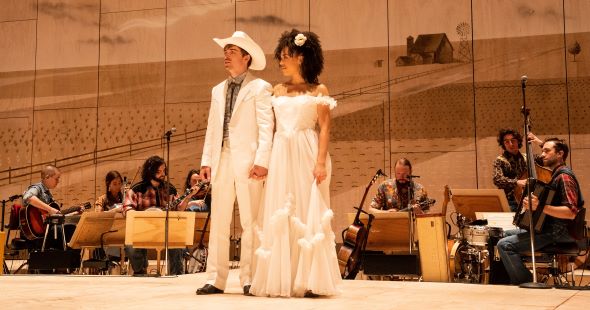

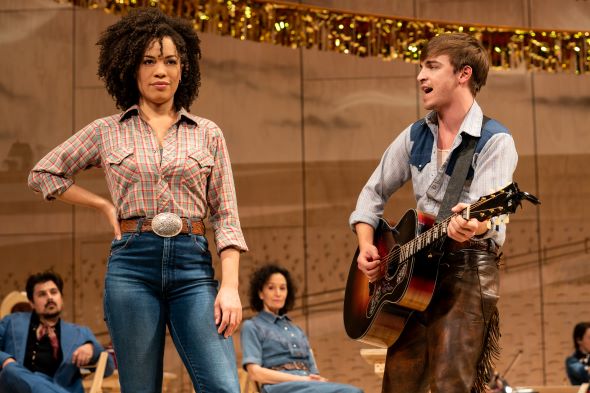
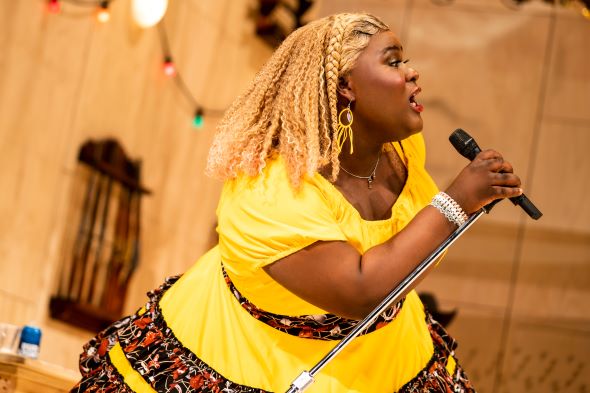
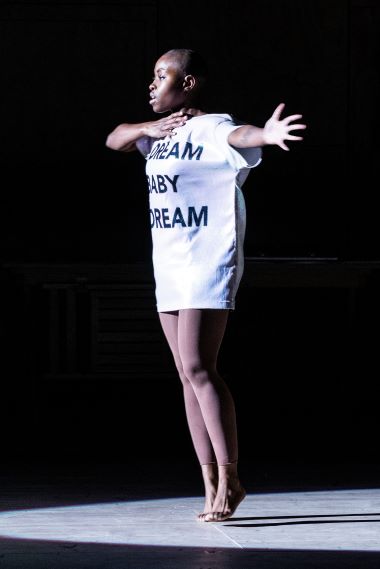

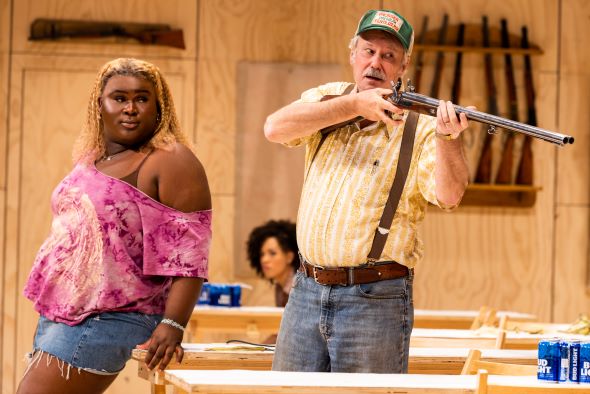
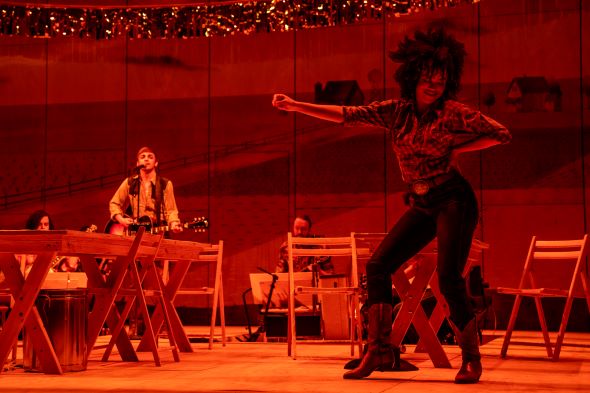

Great review! I couldn’t agree more!!!